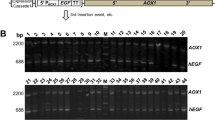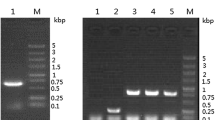Abstract
We have got the humanized antibody with high affinity and specificity against keratin by phage antibody library technology. To improve protein yields and get high affinity and specific anti-keratin antibody, we chose to express it in Pichia pastoris. Anti-keratin ScFv gene from plasmid p3MH/ScFv was subcloned into vector pPIC9K. After confirmed by DNA sequence analysis, the recombinant plasmid pPIC9K/ScFv was transduced into the genome of GS115 P. pastoris. Muts multiple insert transformants were screened by G418 and induced by 5 mL/L methanol to express soluble ScFv. After 6 days of methanol induction, anti-keratin ScFv was efficiently secreted into the medium. Western blot and ELISA assay proved the expressed protein had specific keratin-binding activity. After purification, we examined its effect on cultured keratinocytes by Cell cycle analysis, Which indicated that human ScFv against keratin 17 can inhibit the proliferation of keratinocytes by influence the synthesize of keratinocyte DNA. The successful expression of anti-keratin ScFv in P. pastoris laid a solid foundation for its further application.



Similar content being viewed by others
References
Dang YP, Li W, Li CX et al (2005) Reactivity of IgG class of anti-keratin autoantibodies in healthy human sera. Xi Bao Yu Fen Zi Mian Yi Xue Za Zhi 21:622–624
Li CX, Wan YH, Chi SM et al (2001) Purification of natural antikeratin autoantibodies from normal human serum and their effect on human keratinocytes cultured in vitro. Br J Dermatol 45:737–748. doi:10.1046/j.1365-2133.2001.04469.x
Xing Y, Li W, Fu M et al (2005) Studies on subset, location and secretion of natural keratin-reactive B cells. Xi Bao Yu Fen Zi Mian Yi Xue Za Zhi 21:653–656
Li W, Fu M, An JG et al (2007) Host defence against C. albicans infections in IgH transgenic mice with V(H) derived from a natural anti-keratin antibody. Cell Microbiol 9:306–315. doi:10.1111/j.1462-5822.2006.00786.x
Shen Z, Chen L, Liu YF et al (2006) Altered keratin 17 peptide ligands inhibit in vitro proliferation of keratinocytes and T cells isolated from patients with psoriasis. J Am Acad Dermatol 54:992–1002. doi:10.1016/j.jaad.2006.02.033
Wang G, Liu YF, LI CY et al (2004) Cloning and characterization of antikeratin human antibodies using a semisynthetic phage antibody library. Arch Dermatol Res 296:270–277. doi:10.1007/s00403-004-0504-1
Girault JA, Gorelick FS, Greengard P (1989) Improving the quality of immunoblots by chromatography of polyclonal antisera on keratin affinity columns. Anal Biochem 182:193–196. doi:10.1016/0003-2697(89)90741-0
Priestley GC, Lord R (1990) Fibroblast-keratinocyte interactions in psoriasis: failure of psoriatic fibroblasts to stimulate keratinocyte proliferation in vitro. Br J Dermatol 123:467–472
Cregg JM, Cereghino JL, Shi J et al (2000) Recombinant protein expression in Pichia pastoris. Mol Biotechnol 16:23–52. doi:10.1385/MB:16:1:23
Kalidas C, Joshi L, Batt C (2001) Characterization of glycosylated variants of β-Lactoglobulin expression in Pichia pastoris. Protein Eng 14:201–207. doi:10.1093/protein/14.3.201
Borgheresi RA, Palma MS, Ducancel F et al (2001) Expression and processing of recombinant sarafotoxins precursor in Pichia pastoris. Toxicon 39:1211–1218. doi:10.1016/S0041-0101(00)00265-8
Ridder R, Schmitz R, Legay F et al (1995) Generation of rabbit monoclonal antibody fragments from a combinatorial phage display library and their production in the yeast Pichia pastoris. Biotechnology (NY) 13:255–259. doi:10.1038/nbt0395-255
Eldin P, Pauza ME, Hieda Y et al (1997) High-level secretion of two antibody single-chain Fv fragments by Pichia pastoris. J Immunol Methods 201:67–75. doi:10.1016/S0022-1759(96)00213-X
Dorai H, McCartney JE, Hudziak RM et al (1994) Mammalian cell expression of single-chain Fv (sFv) antibody proteins and their C-terminal fusions with interleukin-2 and other effector domains. Biotechnology (NY) 12:890–896. doi:10.1038/nbt0994-890
Wood MJ, Komives EA (1999) Production of large quantities of isotopically labeled protein in Pichia pastoris by fermentation. J Biomol NMR 13:149–159. doi:10.1023/A:1008398313350
Acknowledgments
This study was supported by the Chinese National High Tech (863) Program (grant No. 2001AA215361) and the National Natural Science Foundation of China (grant No. 30371650).
Conflict of interest statement
None declared.
Author information
Authors and Affiliations
Corresponding author
Additional information
J. Fan and Z. Shen contributed equally to this work.
An erratum to this article can be found at http://dx.doi.org/10.1007/s00403-009-0934-x
Rights and permissions
About this article
Cite this article
Fan, J., Shen, Z., Wang, G. et al. Secretory expression of human ScFv against keratin in Pichia pastoris and its effects on cultured keratinocytes. Arch Dermatol Res 301, 367–372 (2009). https://doi.org/10.1007/s00403-008-0908-4
Received:
Revised:
Accepted:
Published:
Issue Date:
DOI: https://doi.org/10.1007/s00403-008-0908-4




